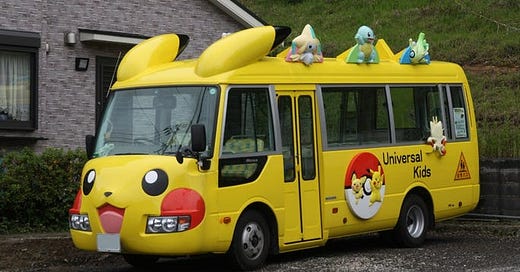Believe it or not, but the world’s largest transit system is not the London Metro or the New York Subway system. It is the humble school bus! In the US alone, 480,000 school buses hit the roads every day to ferry over 26 million students. The distinctive colour and shape have made them ubiquitous in the popular imagination. So how did they get that way? And why have they stayed that way?
Design and History
Why do we need school buses in the first place? Well, we didn’t until the late 1800’s when compulsory education laws started to come into effect. In rural areas, kids would rely on hitchhiking or walking long distances to get to school (I hear from Gran Pappy it was 5 KM up hill both ways in nothing but his socks). Once attendance became mandatory and kids couldn’t spend their days helping out on the farm, districts needed ways to get the kids to school The school bus started in the United States in 1886 with the horse drawn “Kid Hack.” Hack, in this case, being short for Hackney Carriage, the horse drawn predecessor to the cab or taxi, that originated in Hackney, London in 1621.
Kid Hacks were not the comfortable, padded seat kiddie chariots we have today. In 1982, Wayne Wagon Works received their first commission from the Ohio school district for a “school car,” which was a horse drawn carriage with benches around the perimeter. The children entered from the rear of the carriage, so as not to spook the horses. That rear entrance remains today, now known as the emergency exit (that many unsuspecting drivers have been mooned from over the years). A May 1897 complaint from Mrs. W. B. Ashley of Fall River, Massachusetts, said “one of her children was unwell because she was unable to eat her dinners, as the child’s stomach was deranged by the jolting of the wagon.” Sounds like Mrs W. B. Ashley may have needed to improve her flavour game.
With advances in the internal combustion engine, Wayne Wagon Works began to create motorized school cars. Others followed suit, including International Harvester and Ford. Oddly, with all this competition and innovation, protection from the elements only became part of school bus design as late as the 1930s. With the rise in bussing, also came a rise in school bus shelters. These tiny houses live at the end of driveways and serve as designated waiting zones in properties that are set back further from the road so kids can wait for their busses.
The school bus is uniquely universal. Countries from the Philippines to Germany to Cuba all have some version of them. As well, they reflect a commitment to education and the importance of community. School buses connect children in very real ways. They are a shared space but also a liminal one, between home and school. Sounds like a great commute to me.
Innovation
Over time, parents became increasingly concerned with the lax safety standards of school busses. In the late 1930’s, Dr Frank Cyr, an educator and advocate for rural schooling, organized a conference on bus safety that standardized the design of the vehicles. The standards the industry settled on allowed for the beginning of mass production of school busses. Some of the improvements that continue even today include forward facing bench seating and the colour “school bus yellow”. The colour was believed to be the most eye catching colour early in the morning and in the evenings, times when the school bus was most likely in use. Another advancement of Cyr’s (unrelated to the school bus) was that in the 1980’s he got local rural TV stations to show Advanced Placement classes, which was some of the earliest available virtual learning.
The number of school busses boomed in the 50s and 60s with suburbanization of the population. With the consolidation of schools, kids needed to travel further for education. Of the 200,000 one-room schools in the US in 1915, only 1,200 remained open in 1975. More students were now being bussed farther to attend larger schools.
Bussing also became a tool of racial integration in the US. The bus system allowed for integration of previously segregated schools.
There have been continuous design improvements through the years, but the school buses of today still feel very familiar compared to those of our youth. If you find yourself on a school bus today, remember to avoid the hump seat!
Lots of discussion around school bus safety revolves around the absence of seat belts on most school buses. “Mom, why do I have to wear a seat belt in our car when I don’t in the bus?” Based on reported deaths, riding to school in a school bus is actually 70 times safer than driving in a private car. It is through the design of the seats and the busses mass that this level of safety is achieved, even without seat belts. School busses are so large and heavy that their mass is a safety measure in itself. When you crash into a car, both cars are damaged. When you crash into a wall, the wall feels no pain. As a kid, have you ever experienced being thrown into the seat in front of you? Apparently that is what is supposed to happen! As well, studies have been done about the risk that having seat belts in busses poses to occupants. If the bus flipped or there was a need to evacuate. Otto Man, or whoever the driver is, would need to unclip every child’s belt.
Sustainability
Over the past ten years, fleets have begun to transition to electric and hybrid school busses. The recent US infrastructure bill earmarked over $5bn for fleet electrification. School busses are unique in that they sit idle for the majority of the day and have prescribed windows of use. A German company named The Mobility House has begun to use school buses as giant batteries. Essentially, the bus batteries can charge at off-peak times when electricity is cheapest and either use the power to drive their routes or sell that power back to grid during the peak hours, when prices go up. The Lion C is a popular fleet choice for electric school buses and is in service now. It looks just like a traditional school bus, except for the addition of a distinctive blue fender.
Has school bus design been so refined over the past 100 years that it was not possible to come up with a new layout or configuration that makes for a better vehicle? My guess is that regulation around school bus design has become so specific that doing something wildly different is totally out of the question.
I have fond memories of rides on school buses, not only the destinations they took us to but the journey to get there. A couple of years ago, I was responsible for chartering a school bus to get a group of friends to a rural wedding. Not only did we have a great time, but I also made a lifelong friend in the driver (thanks D-Lux for the intro!), who continually texts me some of the worst performing stock picks and investment advice. If you would like access to the “Short Chris the Bus Driver’s Tips Fund” just hit reply.
PS:
The pandemic brought a rise in #vanlife and Skoolies. With supply chain issues and the rising price of RVs, individuals started turning to old school buses and converting them into RVs or mobile homes. A flat nosed school bus can give you 270 sq ft of usable living space. From a personal perspective, this sounds like a great way to spend some time in the great outdoors pretending to be a diesel mechanic (my wife disagrees). The low entry point (maybe its low for a reason?) drew a lot of people in and I’ve been enjoying their bus renos from the comfort of my TikTok. On the high end, firms like Epic Skoolies or Colorado Custom Coach Works can help bring your vision to life. They even do roof lifts! The more DIY-minded or cost-conscious can learn how to give their bus a second life on forums like Skoolie.net.








Really interesting story, thanks